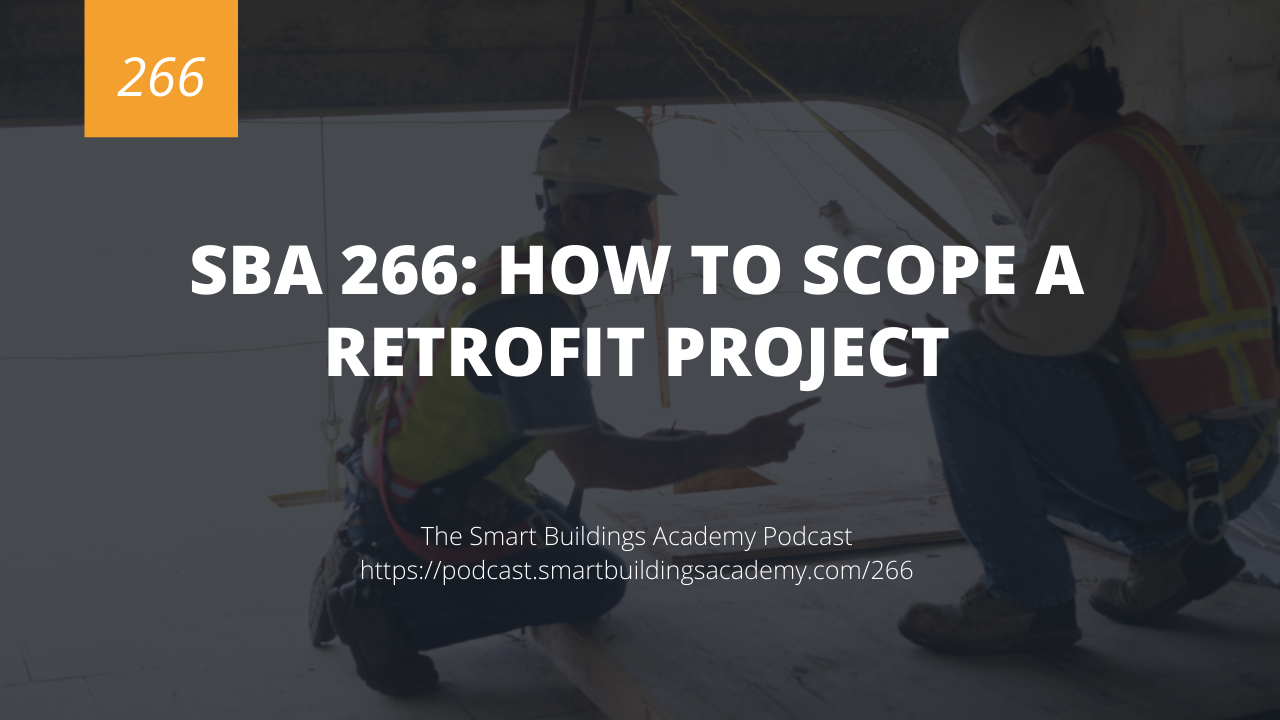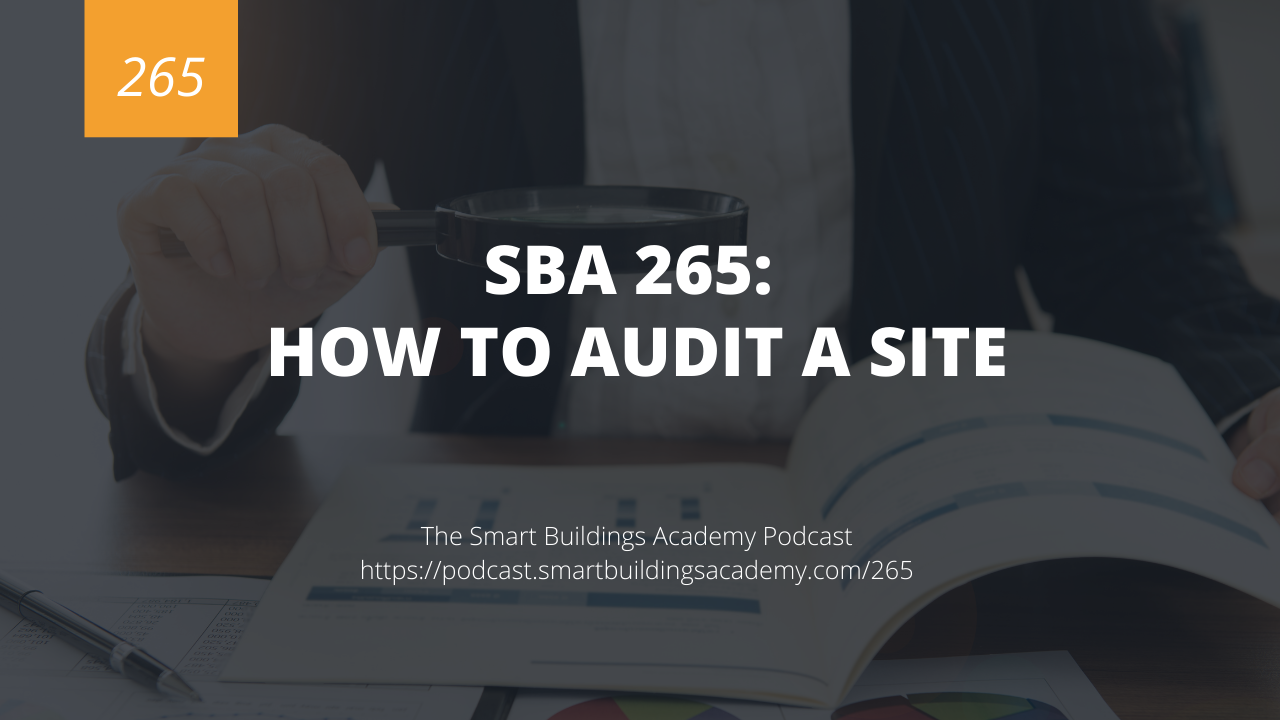In this episode of the Smart Buildings Academy Podcast we discuss the three critical areas you must focus on when you are scoping a retrofit project.
Click here to download or listen to this episode now.
Resources mentioned in this episode


Transcript
Phil Zito 0:00
This is the smart buildings Academy podcast with Phil Zito Episode 266. Hey folks, Phil Zito here and welcome to Episode 266 of the smart buildings Academy podcast. And in this episode, we are going to be specifically focused in on how to scope a retrofit project. Now I realize we've talked about this topic in great detail in the past. And so I want to give you a little bit different of a spin. So in the past, I've talked about how to perform a retrofit project in great detail. We've talked about how to do retrofits, the stance I want to take here is how to actually scope this out how to actually lay out the scope for a retrofit project. So you don't you know, end up hosing yourself later in the project. As always, all details anything you know, we reference is going to be covered at podcasts, smart buildings Academy comm forward slash 266. Once again, that is podcast that smart buildings academy.com Ford slash 266. If I can save the number, right, and this week's episode is once again sponsored by our sales boot camp, if you are looking for a proven way to increase your sales in building automation, or maybe you're getting into building automation sales, and you would like to make sure you hit the ground running with a full pipeline, and you come out of this year, you know hitting your numbers, then this course is for you. It's a live interactive course, that takes place across nine days, Tuesday through Thursday. So across three weeks, and it'll be an hour and a half. Each day, we're going to go through building automation, it h fac scoping, estimating sales, retrofits, site audits, solution sales, service sales, etc. And during that time, I will also be bringing our sales team onto the call. And every one of our sales people here at smart buildings Academy is an experienced and successful salesperson in building automation. So they've sold in service they've sold in construction, they've sold in solutions. And they've done this for large accounts and small accounts. So they will be joining the calls throughout these sessions to kind of give their experience and take as well. So it's gonna be really beneficial for you, I encourage you to sign up, you can do that at podcast, smart buildings, academy.com, Ford slash 266. Now the thing, just some housekeeping here, you're gonna see a significant shift in the topics we're covering on the podcast for probably the next several weeks, we're going to be talking about energy, we're going to be going through consumption, we're going to be talking about demands sub metering, and then we're going to get into actually looking at several integration use cases, we're going to be talking about lighting, we're going to be talking about audio visual access control, and probably some other topics as well. For those of you who don't know, I used to lead the integration program over at Johnson Controls. And I've done an extensive amount of integrations in my past life. So I want to start sharing that information with you. Alright, so let's talk through scoping a retrofit project, what does that look like? Well, what I want you to focus in on with scoping a retrofit project is three things. I want you to focus in, obviously, on the scope, but particularly the scope boundaries, I want you to focus in on that time, and I want you to focus in on validation and execution. So what do I mean by scope and scope boundaries? I want you to get very specific about what systems are in scope, and what systems are not in scope. Now, at first glance, that seems really easy, right? You just sit there and you say, Okay, well, we're retrofitting the controls on the central utility plant, we're retrofitting the controls on the air handlers. And we're adding a new supervisory device. All good, right, except maybe there's some VA v boxes that were integrated into those air handler controls that you're replacing, maybe there was a demand calculation that drove the central utility plant, and that depended on valve position on several air handlers that you're not integrating. And if you don't establish the scope boundaries, if you don't say what is in scope and what is not in scope, then you're going to find yourself being responsible for that because if the customer is expecting it to run the same way it did before and it's not, then you're going to be in for a world of hurt. So how do you deal with this scope boundary issue? What I like to do is I like to work out the sequence of operations for the system and get agreement on the sequence of operations, both the AAS is sequence and the to be sequence. So in the scenario described, and as his sequence would be that the central utility plant is going to run right the chilled water plant is going to run
Phil Zito 5:00
And it is going to adjust chilled water setpoint based on bt you load calculated by, you know, maybe valve position GPM flow rates etc. But the BT you load is going to be calculated and that is going to adjust setpoint that is the as is sequence now the to be sequence would be you know, we're gonna have a static chilled water setpoint, maybe we're integrating or we're investing in a decoupler. And we're going to use decoupled loop control in order to stage on and off chillers based off of you know which way the water's flowing and what the GPS are on the primary and secondary sides. But by clearly defining those boundaries, and this is really important, this is where I see people really get hosed up on their projects, especially retrofit projects is they don't really truly understand the as is conditions and sequences and interdependencies. And because of that they don't address those, and they don't come up with a clear to be, they will often say that they're going to replicate the as a sequence. So we're just modernizing controls, that's all we're gonna do, we're gonna the system's gonna run just the way it did before. But they don't take into account all the little nuances, all the potential integrations that were causing the system to run the way it did before. So it's critical that we do that, it's critical that we understand that. And if you're doing a retrofit, in my opinion, you should always do it to be sequence of operations. And you should truly understand any dependencies. If you are doing a chiller, if you're doing an air handler, just assume there are dependencies in the terminal units, there's dependencies in plant resets and things of that nature and assume they exist, root them out until you can positively prove that they do not exist. That way, you don't get burnt. And that is the same for any kind of project like retrofits where you're doing integrations retrofits where you're doing consumption of existing controls and integration of existing controls, you have to assume that there's things downstream that you may not be covering. And you either have to deal with that through scope exclusion, scope, declarations, scope, boundaries, or you just basically are going to take the risk that no one's going to notice, and hopefully get off the job, which is not a good strategy, in my opinion. Next comes time, I see a lot of people who are very loose with their time, as far as retrofit projects, and I get it, I understand, especially nowadays, everything in the world seems like it's on backorder, I've been trying to go and put a hitch on my wife's Honda Pilot. That way she can carry our bikes, because we're into road biking. And I haven't been able to do that because the hands free adapter has been on backorder for about three and a half months now. Everything seems to be on backorder. And I get that you can't necessarily go and predict when materials are going to show up. And that is a big potential delay. But what you can do is you can go and frame out execution times. So you can say based on normal working hours based on access to materials based on access to the site, this is our projected timeframe. And you need to get customer agreement on this timeframe. Now this becomes even more important when you're working on an occupied building. And even more important when you're working on a critically occupied building like a hospital or a data center where things have to be staged, you have to potentially stand up clean, clean curtains, basically isolation curtains to keep all your construction work from drifting into active areas. So there's a lot of variables, but time is the primary variable. It behooves you, whether you use Microsoft Project, whether you use Excel, whether you use whatever you use to have some form of project planning. And what you want to do when you do this project planning is you're going to have your initiation tab, that's going to be your start, then you're going to have your phases, right, you're gonna have a design and material phase, you're going to have an installation and retrofit phase, you're going to have a test phase, and you're gonna have a closeout phase, you're gonna have four phases. Each one of those phases should have a clear start and end date, they should have any dependencies identified. And you should have man hours associated with that. I always say that you go on the side of caution. So if you're thinking it's going to take you four days, then I would do a 1.5 multiplier for a critical building for like ultra critical building a 2.0. Like if it's a CDC lab, or if it's a prison, something like that. That's like a 2.0 multiplier,
Phil Zito 9:42
a hospital, a data center, those are like 1.5 multipliers, and then 1.25 for schools, office buildings, etc. That's a multiplier placed on top of the time it's going to take you to execute. Once you have this laid out. Make sure that you make it clear that this is not
Phil Zito 10:00
That guarantee of time, and that things may happen because you don't want to get into where you have damages and people are upset. When I say damages, I mean that people are suing you, because they're upset for you delaying their occupancy or something like that. So time, right? And then three is that whole validation, paid part, right. So I said that number one, right. Number one is our scope boundaries. Number two is our time. And number three is our validation, we want to make sure that everything works, we want to even if the customer is not going to pay for commissioning, we want to do some form of functional test. And we want to have customers positive affirmation, usually via a signature on this functional test, that the system meets their design criteria. And this is critical, because I've seen time and time again, where systems change, but habits do not. And I want to repeat that because it's critically important systems change habits do not. If you have a customer whose habit is to manually operate the building, maybe it's a 60 year old, you know, Operation boiler guy, and he comes in, and this happened in my kids School District, right, they went and they did an energy project. And they put in all new controls. And the guy was still going in the crawlspace and manually adjusting valves and was wondering why it didn't work like it used to work. So you have to go and account for the fact that habits will trump new systems, and they will potentially make your retrofit look like it's not working. So you know, you we've defined our boundaries, we've defined our time. And now we need to define our validation, we need to go and say, all right, we are validating using this functional test, we're going to get positive affirmation from the customer that it works, we're going to have logs that it works, we're going to set up an audit log that by contract during this warranty phase, if you want us to support warranty, you must keep this audit log on, you must use this login, do not share your login, they give them a specific login, have an audit log and go and have data trending on the performance variables of the systems. Because you want to be able to go and show Well, yeah, I know it's hot in the building right now. That's because so and so went and overrode all the valves to 20% or to 30% because that's what they're used to doing. Or they really didn't understand the system. And it's critical that you are able to go and point that out. If you hear one thing, actually, if you hear three things, from this podcast episode, get really clear on your boundaries. Go and make sure you have a timeline that the customer has bought into. And make sure there's a validation and positive affirmation that the system works when you hand it off. If you do these three things, you're going to see the slippage of your retrofit projects go down, you're gonna see the margin, the executed margin of your retrofit projects go up, you're going to have a happier customer, you're going to get off the job faster, you're going to be able to forecast your labor better. There's just so many positives to taking this approach when you're scoping. And it all ultimately begins with whoever's scoping the retrofit project. I know especially for a lot of you who work at a smaller organization where you're both the estimator and the salesperson, this is not exciting. This is not enjoyable. It's not selling, you're not going and, you know, bringing in new deals, you're not out there hunting. But this is required. If you're going to play in the world of retrofit, your reputation is what you're going to be held by and being able to take a customer to a site and they say man, ABC Company handled this amazing, they had a timeline, they had clear boundaries, they validated with us after the fact that the system actually worked, I would recommend them. You want to have a library of those kind of opportunities to bring potential customers too. That way, you can sell them on retrofits, which is where I think our industry is going to go. I think we are going to continue to see people not really wanting to build new assets, because of the whole craze of we're not going to move into the office. We're all going to work from home. And with that happening, we're going to see modernization of existing assets to draw people in. Alright folks, I hope this episode helped you hope you learn something from it. Do not hesitate to reach out to me in the comments. I'd love to talk to you about it. Thanks so much. and have a wonderful day. I'll see you on Friday. Take care





